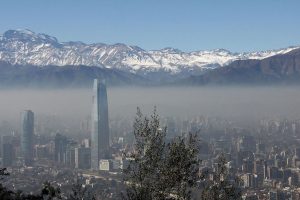By Communications University of Concepción.-Large cities in Latin America reduced nitrogen dioxide pollution by 26% on average during the coronavirus pandemic, while those with fewer than 5 million inhabitants did so by an average of 13%, according to the first study on the subject that relates mobility restrictions -and their effect on transport-, changes in this main atmospheric pollutant and climate variables that could have influenced these NO2 reductions.
The study by scientists from the University of Concepción, “Impact of mobility restrictions on NO2 concentrations in key cities in Latin America during the first wave of the COVID-19 pandemic”, was developed by researchers Matías Volke, Rodrigo Abarca del Río and Claudia Ulloa Tesser.
The cities that presented a significant decrease in NO2 concentrations between March and June 2020 were Lima (47.5%), Santiago (36.1%), Sao Paulo (27%), Rio de Janeiro (23%), Quito (18.6%), Bogotá (17.5%), Buenos Aires (16.6%), Guayaquil (15.3%), Medellín (14.2%), La Paz (9.5%), Belo Horizonte (7.8%), Mexico (7.6%) and Brasilia (5.9%). For these cities, no significant change was observed as a result of meteorological variables such as temperature, wind or precipitation, first compared to the same period of 2019 and also not with a previous decade, according to measurements made with satellites.
Matías Volke is a doctoral student in Energy at the Faculty of Engineering of the University of Concepción, Rodrigo Abarca del Río is a geophysicist in the Department of Geophysics of the same house of studies, and Claudia Ulloa Tesser is a researcher in the Department of Environmental Engineering of the Faculty of Environmental Sciences of the U. de Concepción.
According to the study, there were some cities that increased their concentration of nitrogen dioxide, specifically Asunción, Caracas, Montevideo and Córdoba (Argentina), therefore, in these cases, meteorological variables may have influenced the increase in NO2 concentrations. . For example, the partial quarantine and below-average rainfall from March to May in Montevideo would have increased the probability of high concentrations of the pollutant. Meanwhile, limited rainfall was recorded in Caracas from March to June 2020.
Without climatic effects, Lima, Santiago, Sao Paulo, Mexico City, Bogotá and Rio de Janeiro “exhibited a better average reduction in NO2 concentrations than less populated cities, despite the fact that four of these six cities had only limited quarantines . Thus, the reduction in pollution was greater in places with more inhabitants and fewer restrictions”, highlights the research.
Nitrogen dioxide has a substantial influence on human health directly through inhalation and indirectly through its role as a precursor to secondary pollutants such as ozone and PM2.5 particles that affect the respiratory system. While NO2 emissions from cities are mainly linked to the combustion of diesel and gasoline in the transport sector.
“This study compares tropospheric NO2 records from Sentinel-5P satellite images from March to June 2019 and 2020…In addition, we included the most comprehensive tropoNO2 satellite dataset available from 2011 to 2020, from the OMI mission satellite” , plus the analysis of atmospheric weather with the ERA5 satellite, indicates the investigation. For this reason, the same study indicates in its observations that “these results demonstrate the promise of using measurements based on remote sensors to monitor the response of air pollution to current and future emission regulation policies in cities.”
In addition, the mobility levels indicated by Google and Apple GPS location applications were studied to analyze the real behavior of people affected by the pandemic restrictions during the period analyzed. “Google reported a drop in citizen commuting, an increase in mobility at home, and a decrease in mobility to workplaces and transportation terminals. The decrease in the use of driving and transport registered by Apple supported this hypothesis. Therefore, areas with a high reduction in NO2 concentrations showed a significant link with lower transport-related activity and mobility, the main contributor of NO2.
















